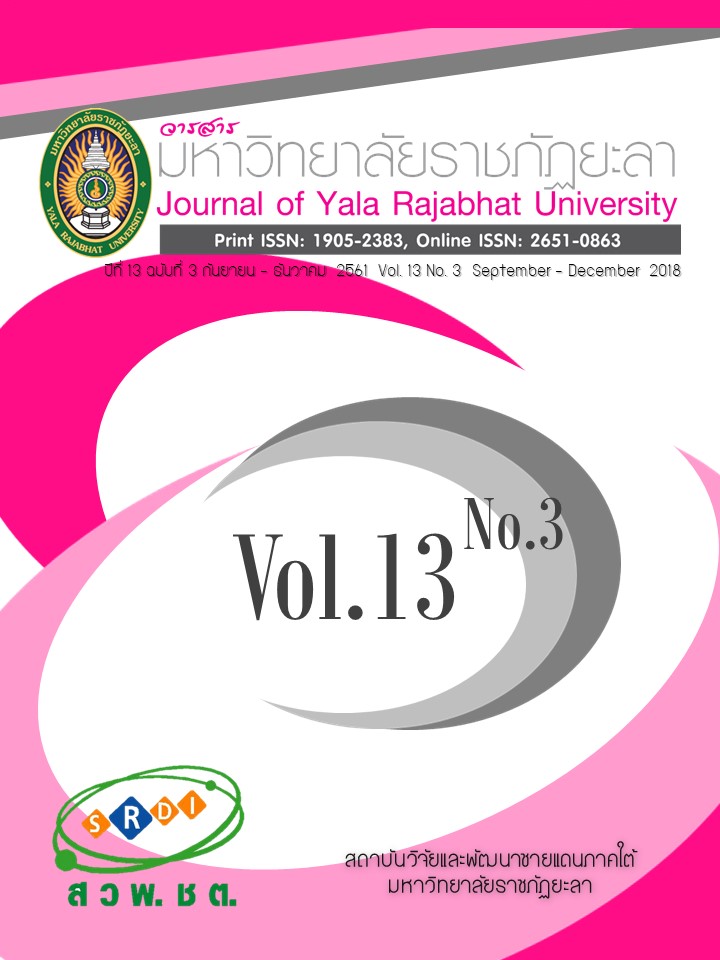การสูญศัพท์ การเพิ่มศัพท์ และการเปลี่ยนแปลงทางความหมายของศัพท์ที่เป็นโทษทางอาญา ในสมัยกรุงรัตนโกสินทร์
Main Article Content
บทคัดย่อ
งานวิจัยฉบับนี้มีวัตถุประสงค์เพื่อศึกษาการเปลี่ยนแปลงด้านศัพท์และความหมายของศัพท์ที่เป็นโทษทางอาญาในกฎหมายตราสามดวง กฎหมายลักษณอาญา และประมวลกฎหมายอาญา ซึ่งผลการวิจัยพบว่า ศัพท์ที่เป็นโทษทางอาญาในกฎหมายตราสามดวงมีอยู่ 164 คำ ปรากฏการสูญศัพท์ 162 คำ เหลือเพียง “ปรับ” และ “ริบทรัพย์” เท่านั้น ที่ยังเป็นโทษทางอาญาจนถึงปัจจุบัน ส่วนการเพิ่มศัพท์ ปรากฏในกฎหมายลักษณอาญา จำนวน 4 คำ ได้แก่ “ประหารชีวิต” “จำคุก” “ให้อยู่ภายในเขตร์ที่อันมีกำหนด” และ “ให้เรียกประกันทานบน” และปรากฏในประมวลกฎหมายอาญา 1 คำ ได้แก่ “กักขัง” เป็นการสร้างศัพท์ด้วยวิธีการซ้อนคำ ซึ่ง “กักขัง” นี้เป็นการเพิ่มศัพท์เพื่อนำมาใช้แทน “ให้อยู่ภายในเขตร์ที่อันมีกำหนด” ส่วนการเปลี่ยนแปลงทางความหมายนั้น พบว่า โทษ “ปรับ” และ “ริบทรัพย์” ในกฎหมายลักษณอาญาและประมวลกฎหมายอาญา มีความหมายแคบกว่าโทษ “ปรับ” และ “ริบทรัพย์” ในกฎหมายตราสามดวง และโดยที่ศัพท์ที่เป็นโทษทางอาญาในกฎหมายตราสามดวงเป็นถ้อยคำสำนวนที่อธิบายให้เห็นภาพของวิธีการลงโทษที่รุนแรง ทำให้ผู้คนในสังคมเกรงกลัวต่อการกระทำความผิด แต่เมื่อศัพท์ที่เป็นโทษทางอาญาในกฎหมายลักษณอาญาและประมวลกฎหมายอาญาได้เปลี่ยนแปลงไปเป็นภาษาวิชาการ ทำให้ภาพสะท้อนอันน่ากลัวของการลงโทษโดยผ่านตัวภาษานั้นสูญสิ้นไป ส่งผลให้ความยำเกรงต่อการกระทำความผิดลดน้อยลงไปด้วย ผู้วิจัยจึงเห็นว่า การกำหนดอัตราโทษให้สูงขึ้นอาจเป็นวิธีการหนึ่งที่จะทำให้คนในสังคมเกรงกลัวต่อการกระทำความผิด เพื่อที่กฎหมายจะได้ทำหน้าที่ในการควบคุมสังคมได้อย่างมีประสิทธิภาพ
Article Details
บทความ ข้อมูล เนื้อหา รูปภาพ ฯลฯ ที่ได้รับการเผยแพร่ในวารสารมหาวิทยาลัยราชภัฏยะลานี้ ถือเป็นลิขสิทธิ์ของวารสารมหาวิทยาลัยราชภัฏยะลา หากบุคคลหรือหน่วยงานใดต้องการนำทั้งหมดหรือส่วนหนึ่งส่วนใดไปเผยแพร่ต่อหรือกระทำการใดๆ จะต้องได้รับอนุญาตเป็นลายลักษณ์อักษรจากวารสารมหาวิทยาลัยราชภัฏยะลาก่อนเท่านั้น
เอกสารอ้างอิง
2. Bradley, D. (1971). Dictionary of The Siamese Language. Bangkok: Kurusapa Printing Ladphrao. (in Thai)
3. Chamnirokasant, D. (1983). Historical Linguistics and Comparative Tai Language. Bangkok: Chulalongkorn
University. (in Thai)
4. Dahayee, W. (2012). Poet Language: Science and Art of Efficient Communication. Journal of Yala Rajabhat
University, 7(2), 163-170. (in Thai)
5. Dictionary of Royal Academy B.E. 2554. (2013). Bangkok: Siriwattanainterprint. (in Thai)
6. Guyon, R. (2007). Drafting Code in Siam. [The Work of Codification in Siam] (Triwate, S., Trans.). Bangkok:
Vinyuchon. (in Thai)
7. Kraiwichien, T. (2012). Thai Legal Language. (11st ed.). Bangkok: Thammasart University. (in Thai)
8. Leangsajjatham, K. (Ed.). (2005). Three Seals Law. Bangkok: Sukkhaphapjai. (in Thai)
9. Likhasitwattanakul, S. (2003). Memorandum of Georges Padoux about Drafting The Penal Code for The
Kingdom of Siam R.S. 127 (1908). Bangkok: Vinyuchon. (in Thai)
10. Mahakun, W. (1980). Law History and Thai Legal Language. (3rd ed.). Bangkok: Facalty of Law Chulalongkorn University. (in Thai)
11. Maneethorn, E. (2009). Political Science. Bangkok: M.T.Press Limited Partnership. (in Thai)
Ministry of Education, Office of the Basic Education Commission. (2012). Thai Standard Vol. 4: Culture of
using thai language. (2nd ed.). Bangkok: OTEP Printing Ladphrao. (in Thai)
12. Nilthongkham, P. (Ed.). (2011). The Criminal Code. Bangkok: Athataya Millennium. (in Thai)
13. Phonkoet, K. (2003). A Stylistic Study of Criminal Code. Master of Arts. Silpakorn University. (in Thai)
14. Suwannachote, J. (1994). A Comparative Study of Legal Styles in ‘Tra Sam Duang’ Laws and
those of the current ones. Master of Education Degree in Thai. Srinakharinwirot University.(in Thai)
15. The Penal Code for The Kingdom of Siam R.S. 127. (2010). Bangkok: Chulalongkorn University. (in Thai)
16. Uppakitsilpasarn, Phraya. (1989). Principle of Thai. Bangkok: Thaiwattanapanich. (in Thai)


